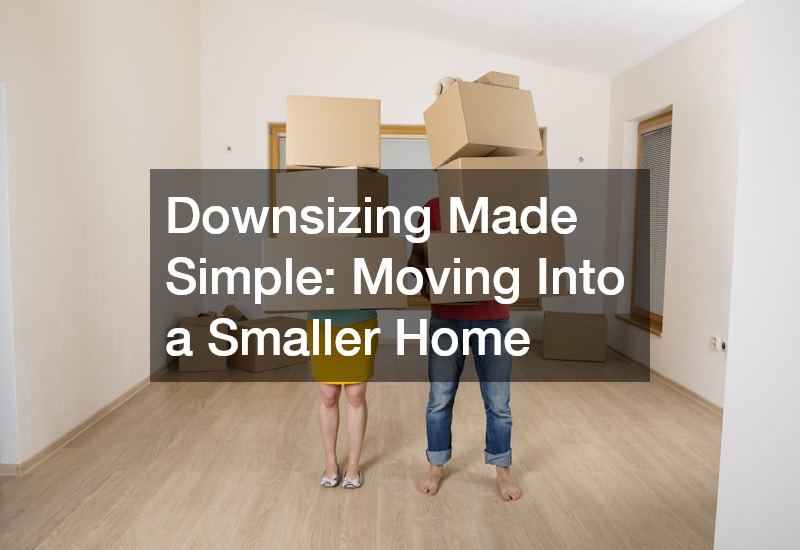This guide takes you from the early mindset shift through the specific logistics of getting from point A to point B without strain. You’ll take stock of what you truly use, learn how to stage your schedule, and protect the pieces that matter most. The aim is not simply to fit everything into fewer rooms; it’s to create a smaller home that lives larger because every inch earns its keep. When you focus on clarity, pacing, and thoughtful execution, the result is less overwhelm and more confidence about your next address. Ultimately, this approach transforms downsizing from a stressful obligation into an opportunity to reshape your lifestyle with intention.
1. Assess Your Current Lifestyle Needs

The first task is redefining what “enough” looks like for your daily life. That starts with a candid review of how you actually use your rooms now rather than how you imagine you might someday. If a formal dining room hosts one holiday meal a year and a guest room doubles as a permanent storage zone, those facts should shape what you keep and what you release. Look at your routines hour by hour—where you read, work, cook, and recharge—and match that with the footprint you’re moving into.
Treat moving as a mental process before it becomes a physical one. Sketch your next layout on paper and test your assumptions about furniture scale and storage density. If an oversized sectional blocks traffic patterns or a king bed crowds closet access, it’s better to learn that now than after a truck unloads. Decide which pieces are non-negotiable because they support your habits and which are merely familiar because they’ve always been there. When needs drive choices, the smaller home serves you rather than squeezing you.
2. Create a Realistic Downsizing Timeline
A smaller residence doesn’t cut the work of a transition in half; it often increases the judgment calls that take time. Build a long runway so you can move in stages and avoid decision fatigue. Early weeks are for measuring, choosing what stays, and setting aside what you’ll sell or donate. Later weeks are for packing zones in a deliberate order and confirming logistics with helpers or hired pros.
Engage local moving companies earlier than you think, not just for transport but to reality-check timing and scope. Their calendars fill fast at seasonal peaks, and your ideal date becomes far more likely when you’re on their radar. Ask targeted questions about staffing levels, insurance coverage, and the time they estimate for a home comparable to yours. A well-paced schedule keeps the process humane; it replaces frantic, last-minute scrambles with steady progress and fewer second-guessing moments.
3. Sort and Declutter Strategically

Editing your belongings is the emotional core of downsizing, and it deserves unhurried attention. Start by identifying the items that actively support your current routines, not the ones that once did or might someday. If you haven’t used something in a year and it doesn’t carry singular sentimental weight, it’s a candidate for release. Sentimental pieces are trickier, but even there, you can choose the best-of-the-best rather than the entire category.
When your resolve wobbles, bring in perspective from local movers—not just for muscle, but for their neutral viewpoint on what packs and places well in compact homes. They’ve seen hundreds of transitions and can flag items that routinely create bottlenecks in tight stairwells and narrow doorways. Pair that input with your priorities so the final collection is both emotionally meaningful and operationally practical. The smaller the canvas, the more each object needs a job and a spot.
4. Maximize Space in Your New Home
Space planning transforms a modest footprint into a comfortable, efficient environment. Begin with accurate room measurements and scale your largest pieces against them, being honest about clearances for doors, drawers, and walkways. Multipurpose furniture helps when used thoughtfully, but avoid cramming a space with features you won’t actually use. Vertical storage, clean sight lines, and light-reflective finishes often do more for livability than one more cabinet that crowds a hallway.
A dependable moving service is invaluable during placement because first positions often become permanent by default. Share your room sketches with the crew chief so items land exactly where they’ll live long-term, saving later strain and floor scratches. If you must keep a heavyweight piece, plan its destination beforehand and stage the path to it so the lift is straightforward and safe. The goal isn’t to bring everything; it’s to bring the right things and land them in the right places the first time.
5. Protect Valuables and Fragile Belongings

Some possessions are irreplaceable, and your plan should reflect that from the outset. Fragile antiques, heirloom dishware, instruments, and sensitive electronics need tailored protection that goes beyond generic boxes. Use appropriate padding, rigid containers, and clear labels that spell out handling preferences. Just as important, designate a personal essentials kit with documents, medications, and the few keepsakes you’d never want out of immediate reach.
For elevated care, a residential moving service can box, cushion, and transport delicate categories with methods designed to survive vibration, temperature swings, and stacking pressure. Their specialized materials and routines reduce the risk that a hurried moment becomes an expensive regret. Think of this as a form of insurance that complements whatever policy you carry. When the most meaningful items arrive intact and accessible, the new space feels like yours much sooner. It also spares you from the stress of constantly checking or worrying about fragile boxes during the move, allowing you to focus on settling in instead of second-guessing their safety.
6. Decide Between DIY and Professional Help
The do-it-yourself route can look economical at first glance, but a compact home often amplifies the physical difficulty of a transition. Tight turns, short landings, and multi-flight buildings magnify the risk of dings and strains. Add in the mental load of coordinating helpers, trucks, access windows, and service elevators, and the savings can erode quickly. There is no single right answer, only the one that aligns with your energy, time, and tolerance for complexity.
If you want the least friction and the clearest handoff of labor, full service packing moving is the premium option. Crews handle the boxing, labeling, loading, transport, and placement, while you concentrate on high-value decisions like what to keep and how to lay out the new rooms. The price reflects the scope, but so does the calm of a process that runs on practiced systems. For many people—especially those managing health constraints or tight deadlines—the lowest stress choice is also the most cost-effective once all factors are counted.
7. Optimize Packing Methods for a Smaller Home

Packing shapes how efficiently you can settle, and in a compact home, efficiency is everything. Group items by where they will live, not where they came from, so each box opens into a coherent zone. Use rigid containers for heavy or sharp-edged items to prevent crushing, and keep a strict threshold for what enters each carton so no box becomes a mystery. Clear written labels beat color codes when you’re tired; future-you will thank present-you for the extra clarity.
Seasoned movers bring hard-earned habits that protect both time and belongings. They know when to double-wall a box, how to float a fragile object in padding, and when to reinforce a seam that might fail after the third lift. Even if you prefer to pack personally, borrowing their techniques reduces breakage and speeds the first days in the new place. Your future comfort depends less on the quantity you transport than on the order in which it emerges and the ease with which it finds a home.
8. Take Advantage of Professional Packing Services
There is an emotional cost to boxing decades of life, and it compounds when deadlines loom. Professional packers turn a daunting, open-ended chore into a defined, scheduled task with a clear finish line. They bring the right materials in the correct quantities, maintain pace without sacrificing care, and leave a paper trail of what’s in each container. That orderliness preserves your decision-making energy for the choices only you can make.
Partnering with a trusted local moving company keeps the operation aligned with your neighborhood’s realities, from parking restrictions to elevator reservations and building rules. Local crews know the quirks of your streets and structures, which lowers the chance of day-of surprises. When time, energy, or health considerations are tight, delegating the boxing work is not indulgence—it’s strategy. The result is a transition that feels planned rather than improvised, which is exactly what a right-sized home deserves.
9. Prioritize Safety During the Transition
Safety isn’t a nice-to-have; it’s the backbone of a successful change of address. Lifting without planning, carrying loads beyond comfort, or rushing through tight corridors can sideline helpers and delay everything. Even well-packed items can become hazards if pathways aren’t kept clear or if stairs and landings are wet, dim, or cluttered. Think of safety as the first schedule you keep, because injuries and accidents are the worst kind of detour.
Choosing providers that explicitly emphasize safe moving services puts trained methods and proper equipment on your side. Crews that use shoulder dollies, forearm forklifts, sliders, blankets, and corner guards treat both people and property as assets to be protected. They pace the day to prevent fatigue-driven errors and stage items before each lift to minimize awkward twists. When the plan respects physics and bodies, belongings arrive without drama and everyone sleeps better afterward.
10. Settle Into Your Smaller Home With Ease
Arrival is a milestone, but the true win is feeling at home quickly. That happens when you prioritize function over speed and resist the urge to unpack everything at once. Start by establishing the daily-life stations—sleep, wash, cook, and work—so routines click into place. As you proceed, keep editing; the best time to decide that an object doesn’t fit your new life is before it claims a permanent shelf.
For longer or multi-leg trips, a dry van trailer rental can preserve the condition of belongings so unboxing feels orderly rather than like triage. Enclosed protection against weather and road grit keeps surfaces pristine, and a sealed, lockable unit lowers anxiety during overnight pauses. Once inside, give each item a destination with intention and avoid temporary piles that become permanent. A smaller space rewards deliberate choices, and the payoff is a home that feels composed instead of crowded from day one.
A right-sized home is less about subtraction and more about concentration—fewer things, yes, but also clearer priorities and easier days. By assessing how you live, staging your schedule, editing with care, and protecting the pieces that matter, you trade square footage for focus. The process can stir memories and test patience, yet the outcome is a space that serves today’s version of you, not yesterday’s. That is the real promise of a smaller home: it gives back time, attention, and calm that clutter quietly steals.
If you proceed with intention, your next address won’t feel like a compromise; it will feel like a fit. You will have chosen what earns a place, planned how it lands, and created room for routines that actually sustain you. In a world that constantly urges “more,” choosing “enough” is both practical and powerful. And when the door closes behind you on that first night, the relief you feel won’t be about the size of the home—it will be about the clarity of the life you’re building inside it.







